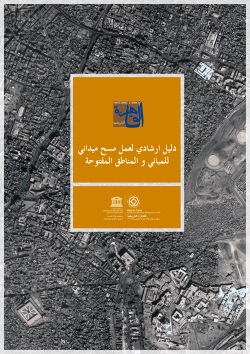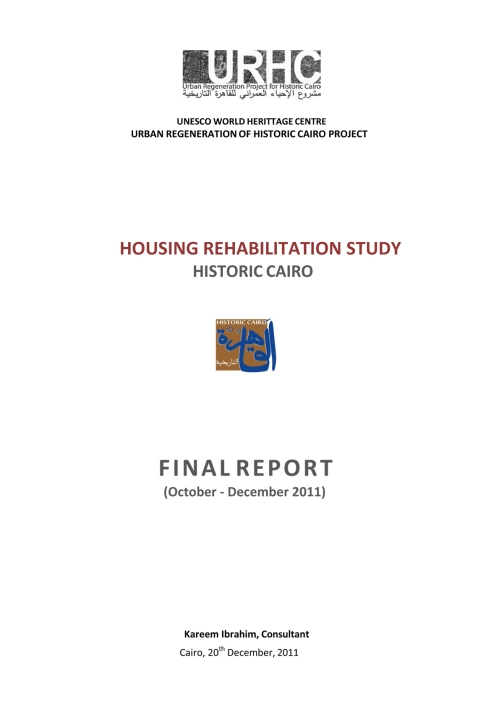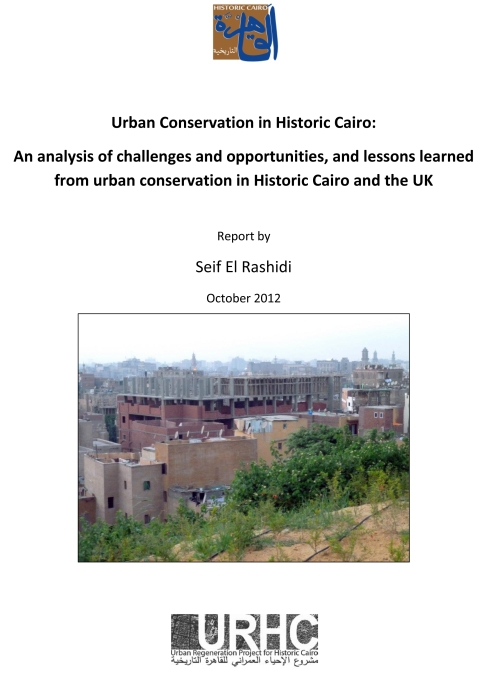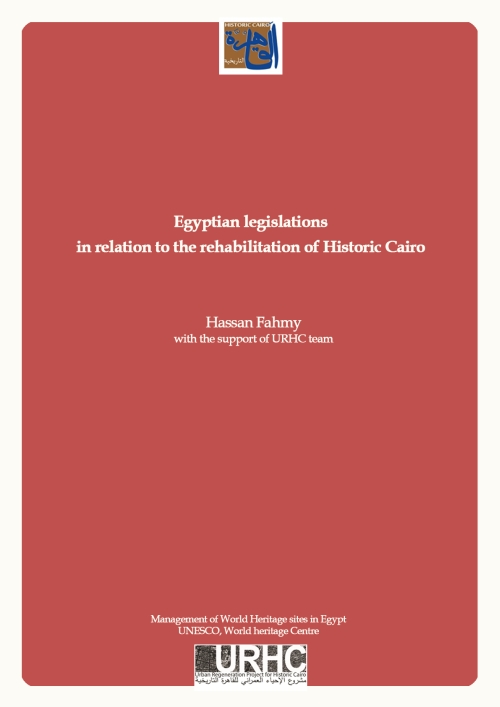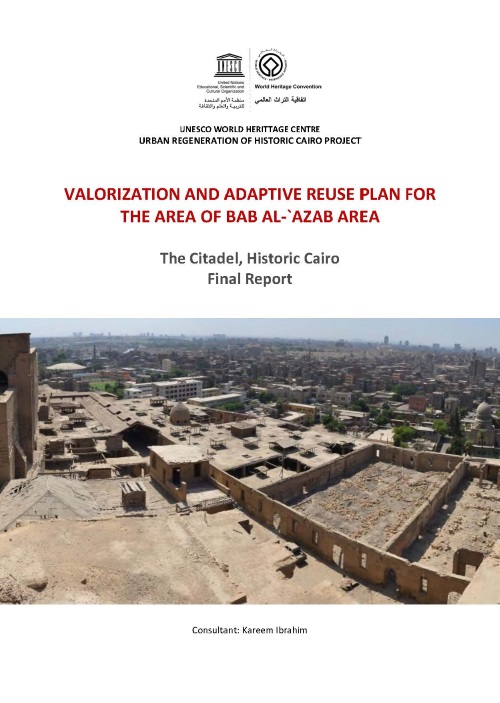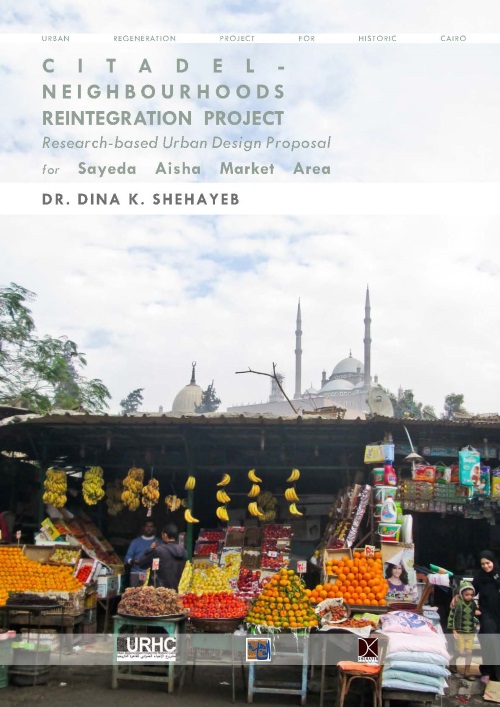Studies
URHC project documents and reporting (EN-AR)
The final report collects the activities of URHC done from 2012 to 2014. It concentrates on the development of studies and analysis on the Action Project Area, as a strategic sample representative of diverse issues of the WH Property. It addresses the realization of inventories of buildings and open spaces, and develops specific studies and proposals for major open spaces and the core monumental area of the Citadel, particularly the lower enclosure of Bab el Azab.The report is in both English and Arabic languages.
"The Guidelines" is a manual produced in English and Arabic developed through a training-on-the-job activity with trainees from concerned Egyptian Institutions. It is conceived as a tool to support the activity of technical staff within the governmental institutions for the compilation of buildings and open spaces inventories. Drafted on the structure of survey forms proposed by URHC, it articulates criteria and parameters of evaluation for each surveyed aspect, thus to equip the surveying team with compatible and homogeneous assessment standards.
This report traces the project first two years of activity. It is comprehensive of the studies done for the identification of the boundaries for the core and buffer zones, a first draft of protection measures to halt the ongoing destruction of the site; the Identification of the outstanding Universal value of the site and finally the integrity of heritage values through an extensive on-field survey.
In the framework of the “Urban Regeneration for Historic Cairo” an Action Project has been proposed as a case for the conservation of the historic city through an approach of “rehabilitation” and “regeneration”, and as a step towards the development of a Conservation Plan for the Historic Cairo World Heritage (WH) site. This report outlines the area, the scopes and targets of the action project.
This monument study is part of a series of in-depth studies conducted within the study area to profile the main aspects of the site and to present management and conservation issues relevant for future planning.
The study helped to identify the state of conservation of the monuments and to suggest a list of priority actions. Furthermore, it will highlight trends and major issues to address regarding the functional and spatial integration of these monuments into the urban fabric and their possible adaptive re-use.
Crafts represent a crucial aspect of Historic Cairo heritage values and living traditions, but are seriously threatened by social and economic pressures. At the same time they represent an important physical feature of the urban fabric, as they are closely intermingled with housing and public open spaces. Safeguarding traditional crafts and community-oriented activities and developing other compatible economic activities should represent a major objective in any urban regeneration and revitalisation policy. The study was based on a field survey in some selected neighbourhoods of the Study Area, and aimed to gather information about all existing workshops. It also made recommendations for how to complete and enrich the regulatory and urban design proposals.
Following the political unrest during 2011, the building activity in Historic Cairo increased exponentially with alarming patterns. During a first systematic survey carried out by the Urban Regeneration of Historic Cairo (URHC) in 2011, problems concerning the building activities, the state of conservation of the monuments, the waste disposal management and the environmental hazards in Historic Cairo were documented. This study is meant to identify the violation concerning the building activity within Historic Cairo
Signage can play a major role in providing information and increasing awareness about heritage values of the urban fabric and the monuments for the resident community, not only for visitors. A dedicated study was carried out on the current situation in Historic Cairo with the goal of developing potential guidelines and design parameters in line with the strategy of promoting the city’s tangible and intangible heritage.
URHC sector studies (EN)
This report collects and analyzes few relevant studies and projects on monuments restoration and urban rehabilitation, implemented or under implementation and planned within the W. H. site and its buffer zone in the last decade by the Ministry of Culture at first, and the Ministry of Antiquities after.
The report was assigned to identify and classify the environmental risks present in Historic Cairo. The definition of risk was associated to the threat to safety, heritage values as well as to the quality of life in the historic city. A further differentiation is done between the hazards that are found throughout the greater Cairo region, and those instead that are specific to the historic city.
This study outlines the social characteristics of Historic Cairo in relation to the larger metropolitan area; including the demographic structure, social structure, other practices, and general attitudes. It portrays the general quality of life, comprising a number of different factors, including housing conditions, infrastructures, income level and livelihoods. With a planning perspective it identifies distribution and density of social services and the level of social justice.
The study identifies the community-oriented activity patterns and indicates the spatial localization points of the most relevant patterns. It analyses the different types and modalities of appropriation and use of public space: revealing existing and possible conflicts and constraints on one hand, as well as practices and potentials for sustainable and participatory place management on the other. Finally it outlines the critical issues and identifies the potential for revitalization.
The purpose of this study is to give a broad overview of the potential for housing rehabilitation in Historic Cairo. It provides a brief description of the housing rehabilitation and it provides an initial characterization of the housing sector, outlines housing rehabilitation issues, opportunities and constraints related to Historic Cairo. Moreover, this study provides and prioritizes recommendations for further action and details of a comprehensive rehabilitation study.
The report is a preliminary study on the solid waste management in Historic Cairo. It collects and organizes the existing available information. It provides an initial description of the current different types and modalities of public services and community practices for the waste disposal; and it outlines the critical issues. It finally sketches out a program for a comprehensive study on Historic Cairo to design a waste disposal system in the framework of the Historic Cairo WH site management.
The report outlines the challenges and opportunities that the management of Historic Cairo implies, the analysis is based on the experience of the consultant in his work for the Aga Khan Trust for Culture between 1998 and 2008 and on the experience of coordinating Durham Cathedral and Castle World Heritage Site since 2008, including the review of the Management Plan for that site.
This report focuses upon the consequences on livability of Historic Cairo (HC) of the uncontrolled spreading of formal and informal commercial and productive activities into the public spaces by analyzing how this affects the urban fabric with regard to: heritage values, residential and other non-residential uses, mobility and accessibility, environmental conditions and risks.
This study is focusing on housing rehabilitation issues in Historic Cairo, highlighting the need for maximizing value of frozen and underused assets. To this effect, the study focuses on dilapidated areas in Historic Cairo by conducting a plot‐by‐plot survey to obtain more in‐depth information and explore possibilities of maximizing the use and value of frozen and underused assets. To this effect, two areas were deeply studied: Arab Al Yassar and Boulaq Abul‐Ela.
The study targets the cemeteries in its different urban nature as a built-up multifunctional part of the historic settlement. It addresses the relatively high concentration of monuments, shrines, and buildings of architectural value that suffer from a different set of conservation problems; its importance as religious and touristic destination; and the threats represented by planning and development proposal that could alter the nature and the integrity of the place.
This report drafted by URHC team on the outcomes of reporting of the Legal consultant Hassan Fahmy provides an overview and initial analysis on the Egyptian legislations that play an important role, influence or sometimes hinder the protection of the World Heritage property of Historic Cairo. Furthermore some special studies addressed the organization lines and recesses, the violations and related penalties.
This study reports on a series of activities launched in the framework of the awareness campaign of the project. The various activities were set in accordance to the URHC team initiative of field survey in the action project area, and implemented in parallel in the same area. Thus, to raise awareness on the project scopes and activities, as well as on the heritage value of Historic Cairo World Heritage city. Different stakeholders were the target of the community events: Government technical staff, residents of the area, citizens and governmental manager and decision makers.
This study focuses on the intangible aspect of historic Cairo’s heritage; particularly on the collection and synthesis of stories related to a specific area in the city and its characters (the action project area). The outcomes of the collected stories were performed live in a storytelling event on the streets and in the buildings of the area. The aim of the study is to promote citizens participation and to profile, on one hand, the residents needs and on the other hand, the set of intangible values, meanings and urban dynamics.
The Study documented with a comprehensive survey of the southern end of Mohamed Ali Street, from Helmeya Street to Citadel square with the objective of making a proposal for the rehabilitation of the southern end of Mohamed Ali street -the 19th century dilapidated spine which used to provide access to Citadel square-, with an emphasis on the upgrading of commercial activities, services and streetscape.
The poor and ineffective management of solid waste represents one of the most difficult challenges for improving the liveability and environmental conditions of Historic Cairo. A dedicated study was carried out in Study Area to highlight the weaknesses of the present system and to provide a vision and technical proposals for a more effective organisation of this essential service. A pilot area was selected to carry out a comprehensive analysis and to define a possible policy based on a series of strategic objectives.
The study carried out a detailed survey and assessment of all the identified buildings of heritage value to be preserved in the area of Bab el Azab. It included for each building schematic plans and sections (1:200 drawings), and information on period(s) of construction, architectural typology, building materials and techniques, state of conservation, and other information relevant to evaluate the heritage value.
It identified the critical issues and typical pathologies and provided general guidelines for the physical restoration of materials, structures and decorative elements for each of them; while proposed adaptive reuse alternatives. It finally identified priority conservation actions and technical feasibility of possible conservation/restoration projects for each building, including the legal and institutional aspects.
The study develops an adaptive reuse and valorization plan for the area of Bab Al‐‘Azab in the Citadel taking in consideration the social, physical and economic potentials of the site.
The study is based on the understanding of the historical background of the site, the socioeconomic profile of the surroundings urban areas, and the existing conditions of the site. It reflects the perceptions o different stakeholders and includes a documentation of the current conditions of the site based on previous drawings of the area updated by the study team through digital surveys.
The study focuses on the open spaces of Sayeda Aisha Street and Salah el Dien square, as major public spaces in the study area, and as key components to address in order to achieve a sustainable heritage conservation practice. It investigates the dynamics of appropriation of public space by the different market activities in the market of al Sayeda Aisha Street and their impact on the life of the neighbouring residential areas. It drafts a proposal of physical re-organization and management of the market area to reduce its functional and spatial disorder, the lack of appropriate infrastructure and hygienic services and to relief the vehicular traffic circulation. It also explores the connection between the local communities along al-Sayeda Aisha Street and the Citadel; both the view from the street, and the accessibility to Bab el-Azab and the adaptive uses it would house. This by studying the area of Midan Salah al-Din space with its two streets and Middle Island currently occupied by services, a museum and public gardens.
Awqaf properties are widespread in the urban fabric and represent an important component of the building stock. The study highlights the institutional and legal aspects regulating their management and document their extent and conditions via a field survey. Some opportunities for rehabilitation and regeneration have been detected in “priority areas”, based on the information provided by the Inventory. These should be considered by the relevant administration for possible interventions.





